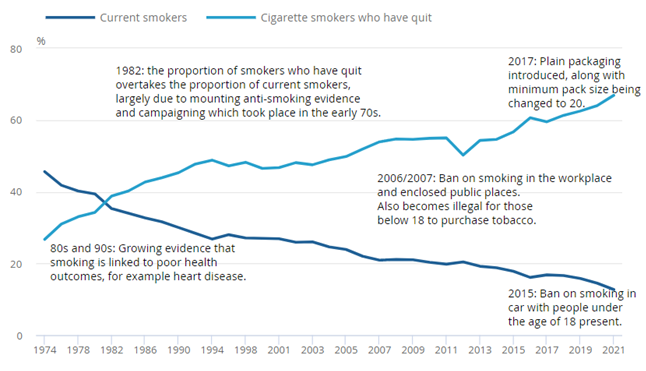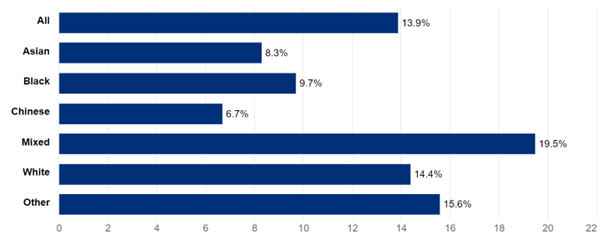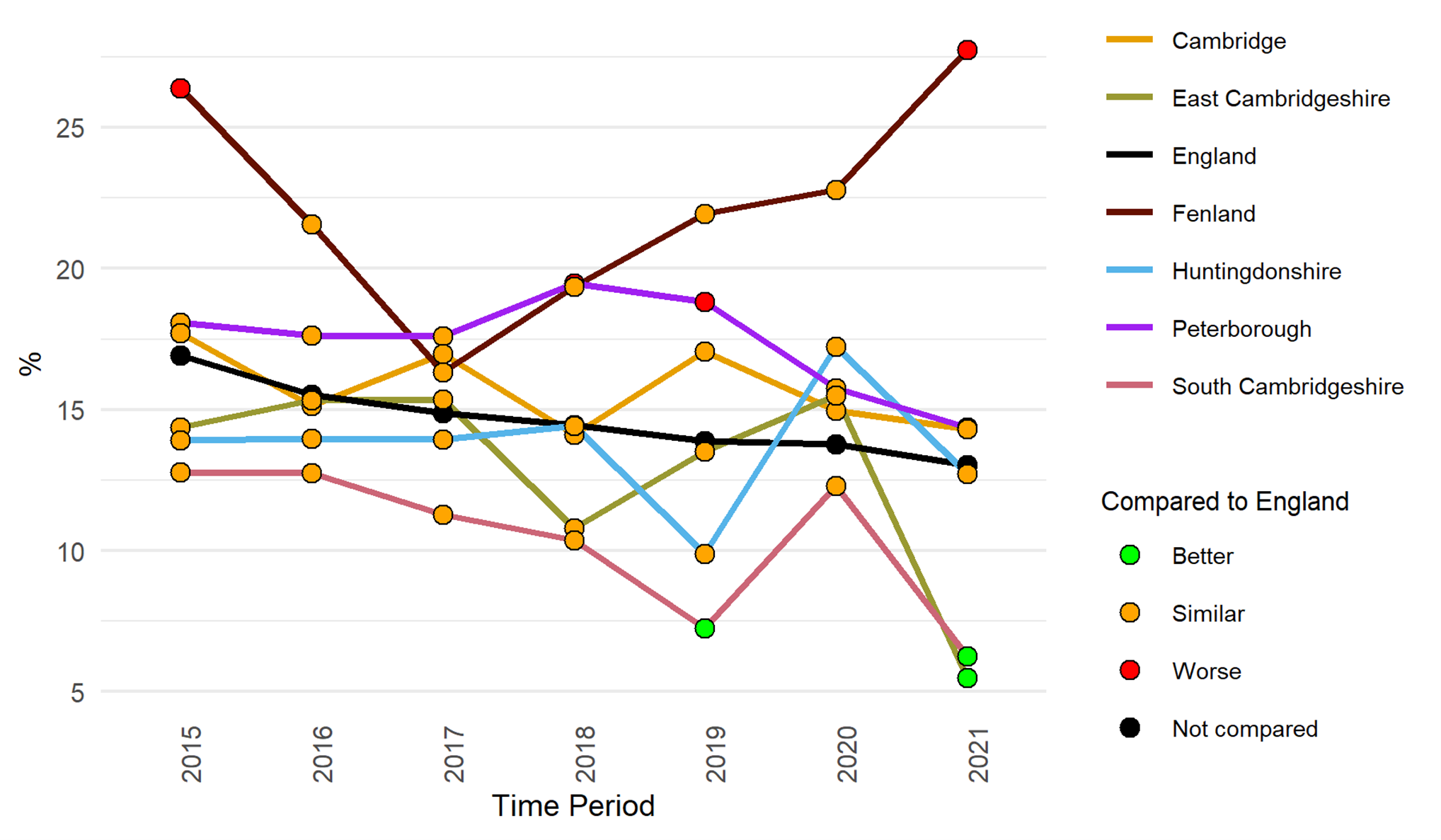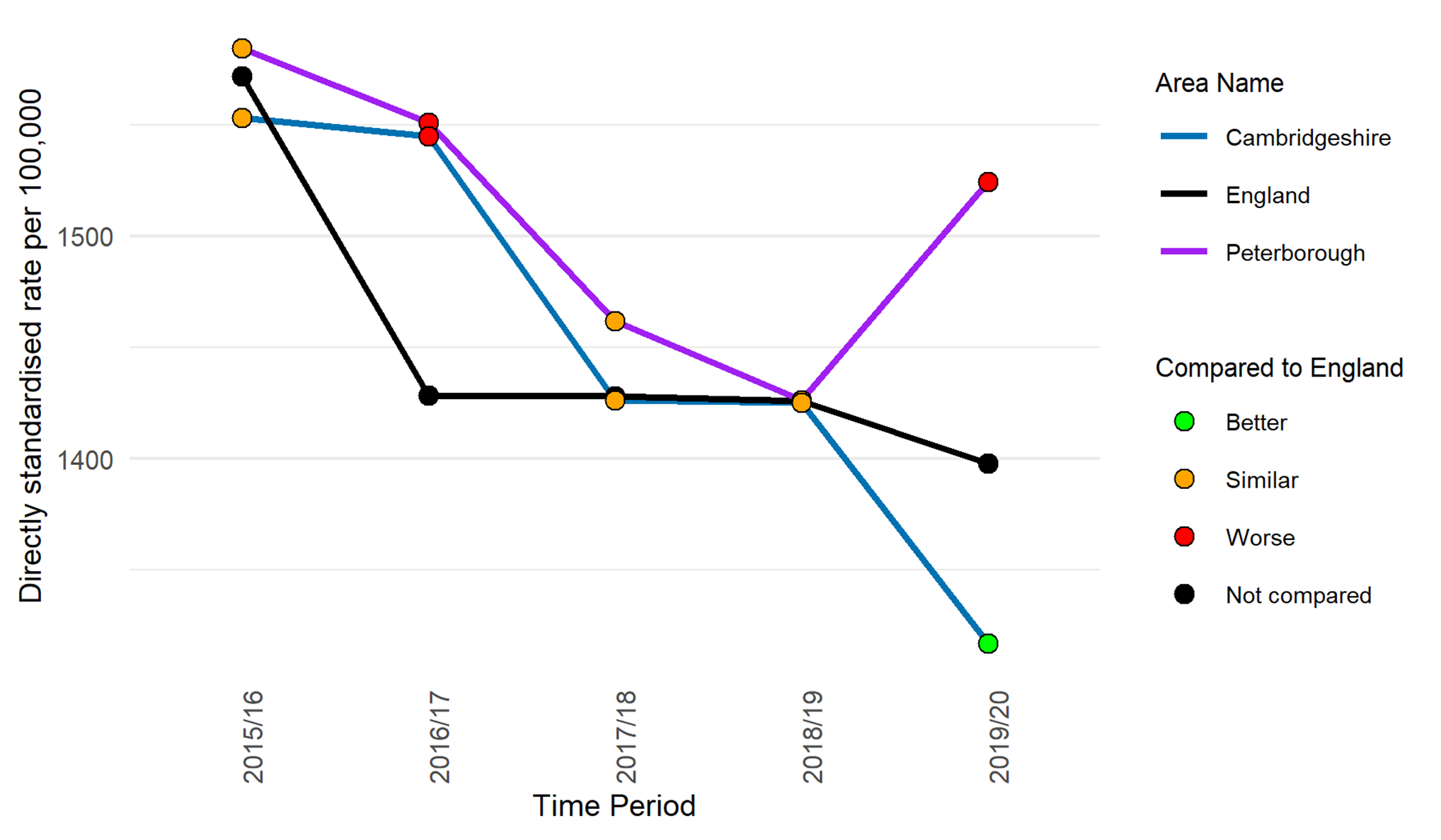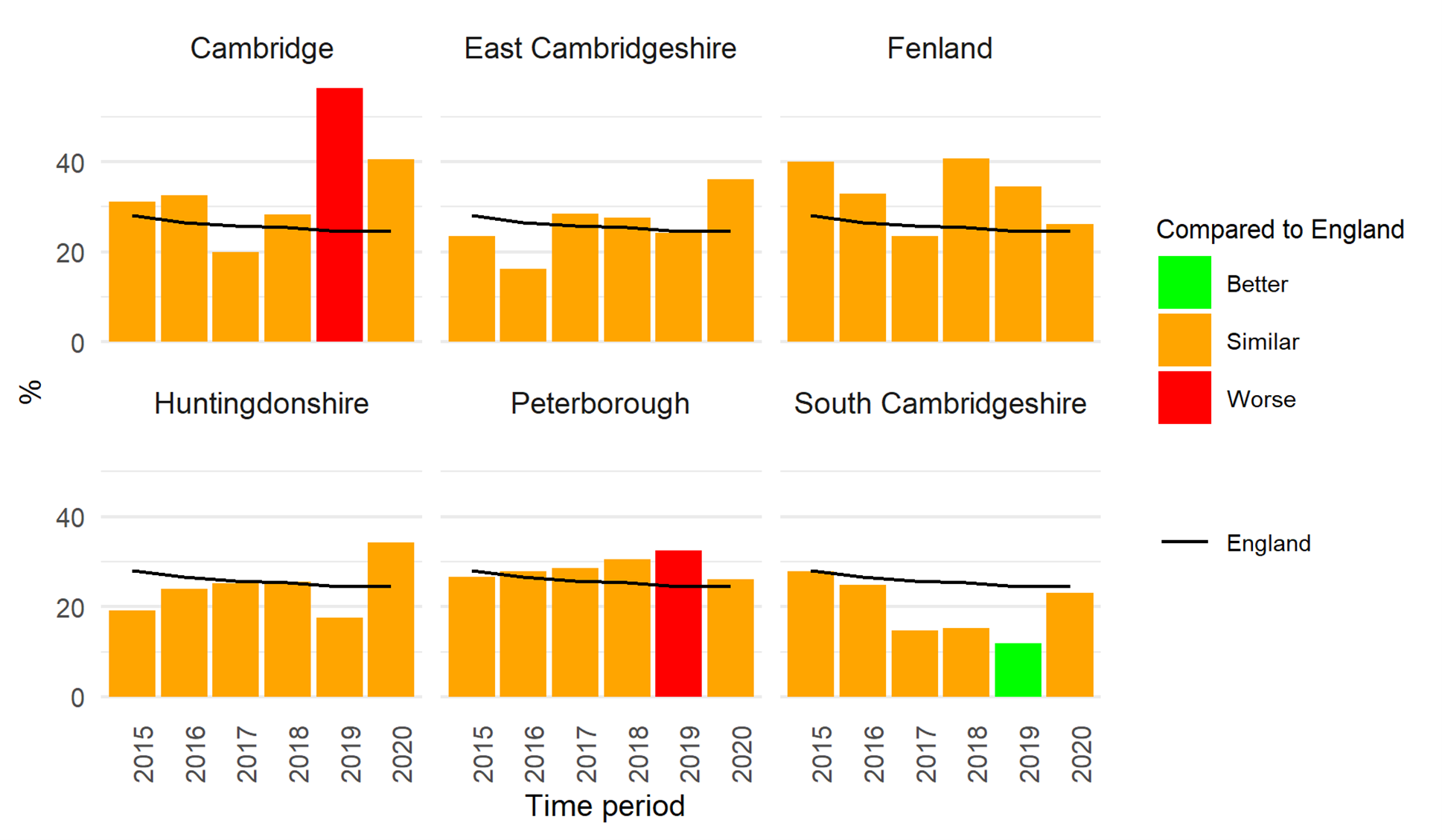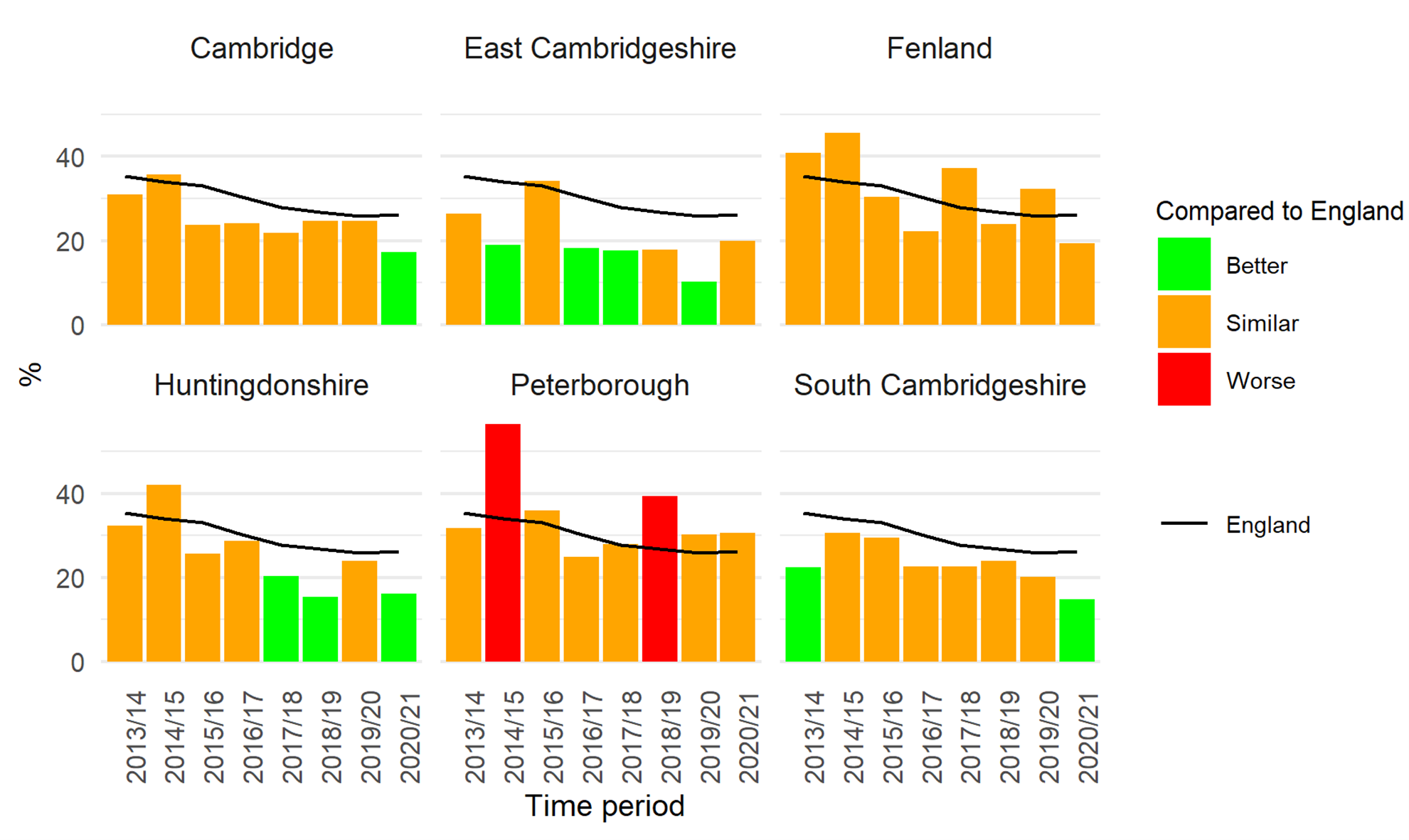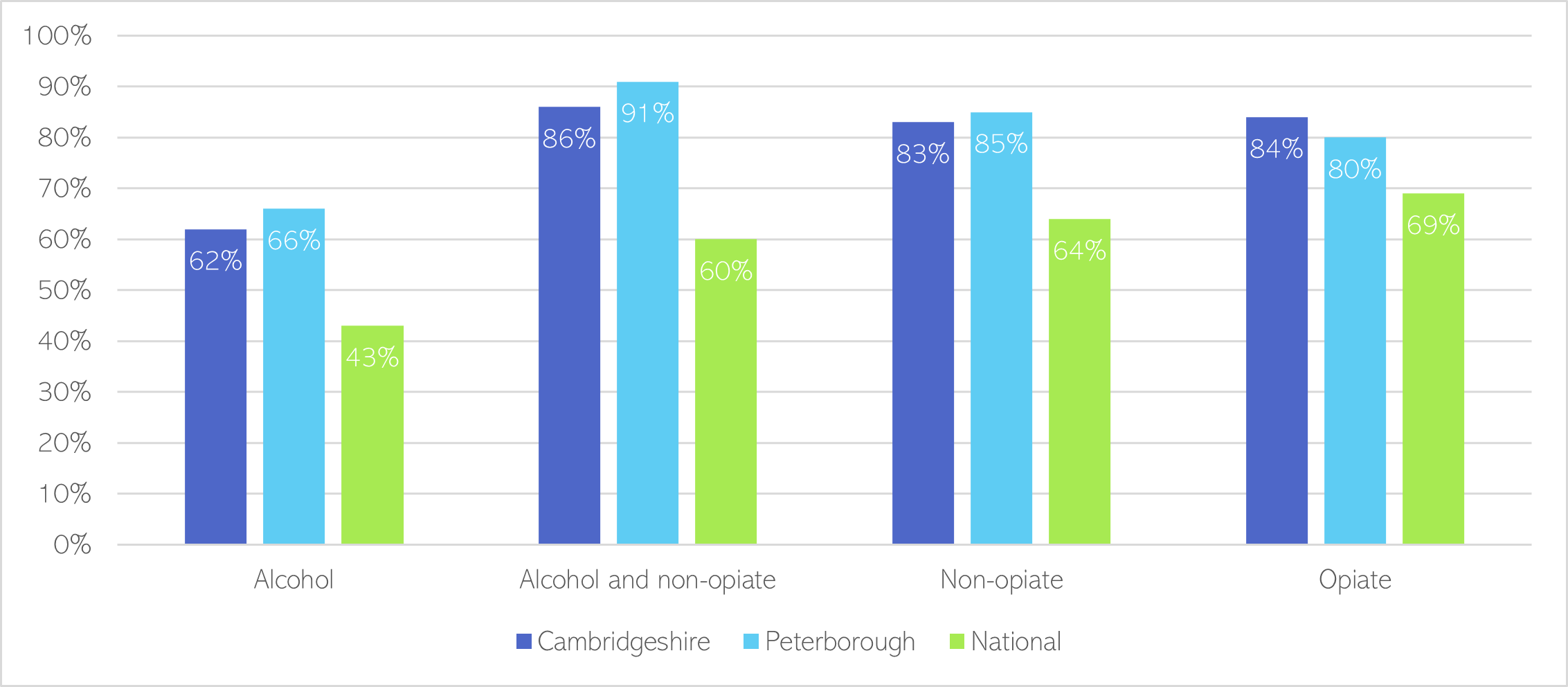What is the link between smoking and mental health?
Figure 80: The links between smoking and mental health. Data sources: (Royal College of Physicians of London & Royal College of Psychiatrists., 2013),(Wildgust & Beary, 2010)
- Smoking is the single biggest cause of preventable death and illness in England (Office for National Statistics, 2020a).
- People with mental health conditions are more likely to smoke than the general population: a third of all tobacco used is smoked by people with a mental health condition (Royal College of Physicians of London & Royal College of Psychiatrists., 2013).
- People who smoke and have a mental health condition are more likely to be heavily addicted to cigarettes than smokers in general (Royal College of Physicians of London & Royal College of Psychiatrists., 2013).
- Smoking is a significant contributor to low life expectancy faced by people with severe mental illness (Wildgust & Beary, 2010).
Why are people with mental health conditions more likely to smoke?
- Some factors, such as experiencing a stressful event, can trigger both smoking and mental health conditions like depression (Mendelsohn, 2012).
- It can be hard for people managing mental health conditions to prioritise quitting smoking, particularly if they use smoking as ‘self-medication’ for their symptoms (Sheals et al., 2016).
- There is some evidence of a bidirectional relationship between smoking and mental health: chronic smoking increases the risk of depression (Mendelsohn, 2012).
- Healthcare professionals sometimes believe that people with mental health conditions are not interested in quitting and that this would be ‘too much’ for them to take on (Sheals et al., 2016), despite this group being no less likely to want to quit than the general population (Royal College of Physicians of London & Royal College of Psychiatrists., 2013).
- Quitting smoking has a similar benefit in terms of reducing anxiety and depression symptoms as antidepressants (Taylor et al., 2020).
- NICE guidance states that people with severe mental illnesses should be offered additional support with smoking cessation if this is needed (NICE, 2022). Services that are specifically targeted towards the needs of people with severe mental illnesses, such as by providing home visits and face-to-face support, have been successful (Gilbody et al., 2019).
What is the national picture?
Across Great Britain, there had been a steady decline in the proportion of people who smoke over the past 50 years (Office for National Statistics, 2020a). However, there has been little change in smoking rates in people with mental health conditions over this time (Royal College of Physicians of London & Royal College of Psychiatrists., 2013).
Figure 81: The proportion of current smokers and smokers who have quit in Great Britain, 1974 to 2021. Source: ONS
34% of adults with common mental health conditions smoke (Royal College of Physicians of London & Royal College of Psychiatrists., 2013). Smoking prevalence varies somewhat by type of mental health condition, with those who have PTSD, phobias and obsessive-compulsive disorder being most likely to smoke. 34% of adults with common mental health conditions smoke (Royal College of Physicians of London & Royal College of Psychiatrists., 2013). Smoking prevalence varies somewhat by type of mental health condition, with those who have PTSD, phobias and obsessive-compulsive disorder being most likely to smoke.
Table 31: Smoking prevalence by mental health condition. Source: (Royal College of Physicians of London & Royal College of Psychiatrists., 2013)
- Some population groups are at a high risk of both smoking and having mental health conditions (Royal College of Physicians of London & Royal College of Psychiatrists., 2013):
- 82% of women in prison and 77% of men in prison smoke.
- 77% of people experiencing homelessness smoke.
- The proportion of adults who smoke is higher than the national average (13.9%) amongst people from mixed ethnic backgrounds (19.5%) and people from White (14.4%) ethnic groups (Office for National Statistics, 2020a). This survey did not collect enough data from people from ‘Other’ ethnic groups, hence it is not possible to draw generalisations about smoking prevalence for this group.
Figure 82: Percentage of adults that smoke, by ethnic group. Source: ONS
What is the local picture?
- Trends of smoking prevalence vary across Cambridgeshire and Peterborough, despite a national decline in smoking since 2015 (Office for National Statistics, 2020a).
- The smoking prevalence in Fenland (27.8%) in 2021 was the highest out of all local authorities in the UK.
- However, smoking prevalence is below the national average in South and East Cambridgeshire; and close to the average in Cambridge, Peterborough and Huntingdonshire.
Figure 83: Smoking prevalence in adults (18+) in Cambridgeshire and Peterborough. Data source: Fingertips
The rate of smoking-attributable hospital admissions was significantly above the national average (1,398 per 100,000) in Peterborough (1,524 per 100,000) in 2019/20, whilst they were below average in Cambridgeshire (1,317 per 100,000) (Office for Health Improvement and Disparities, 2023).
Figure 84: Hospital admissions for diseases wholly or partially attributable to smoking in adults aged 35 or over in Cambridgeshire and Peterborough, per 100,000 of the population. Data source: Fingertips
The smoking prevalence for people in routine and manual occupations was close to the national average (24.5%) in all Cambridgeshire districts (32.6%) and in Peterborough (26.0%) in 2020 (Office for Health Improvement and Disparities, 2023):
- In Cambridgeshire, people in routine and manual jobs are 2.8 times more likely to smoke than those in managerial and professional occupations.
- In Peterborough, people in routine and manual jobs are 2.0 times more likely to smoke than those in managerial and professional occupations.
Figure 85: Smoking prevalence in adults (aged 18 to 64) in routine and manual occupations. Data source: Fingertips
Smoking prevalence amongst people with mental health conditions
Across all areas of Cambridgeshire and Peterborough, the smoking prevalence amongst adults with long-term mental health conditions was similar to or below than the national rate in 2020/21 (Office for Health Improvement and Disparities, 2023). Smoking rates were similar to or lower than the previous years in all areas apart from East Cambridgeshire, in which there was a significant increase in smoking prevalence (from 10.3% to 20% over the past year) (Office for Health Improvement and Disparities, 2023).
Figure 86: Smoking prevalence in adults (aged 18+) with a long-term mental health condition. Data source: Fingertips
Smoking prevalence in people in substance use treatment
The smoking prevalence in people who are in substance use treatment is higher than the national average in Cambridgeshire and Peterborough.
Figure 87: Proportion of people entering treatment for substance use who indicated smoking in at least 1 of the 28 days prior to starting treatment. Data source: DOMES
Additional resources
- The local data pack gives an overview of key data and trends
- NIHR summary of how health behaviours are important to public mental health
- Smoking and mental health: a joint report by the Royal College of Physicians and Royal College of Psychiatrists
- King’s Fund Tackling multiple unhealthy risk factors: emerging lessons from practice
References
Full list of references is included at the end of this chapter.


